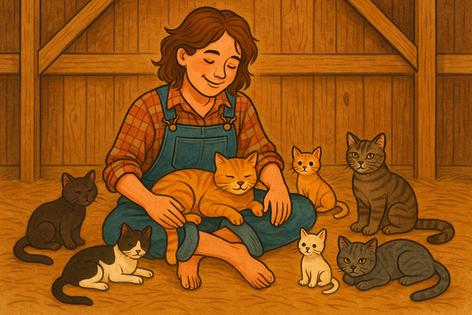The Working Cat: Real Stories of Felines on Farms, in Warehouses, and Even Offices
Published in Cats & Dogs News
Mouse patrol with whiskers and claws
Long before they became pampered companions sprawled across sunlit windowsills, cats held a more rugged role. They were workers. On farms, in factories, and lately—even in tech offices—cats have earned their keep by keeping pests at bay, providing stress relief to employees, and even building community engagement.
While many associate the term “working animal” with dogs, horses or oxen, the quiet diligence of the working cat is often overlooked. Yet for centuries, cats have proven themselves invaluable partners in places where rodents and other small nuisances could do real damage. Unlike their canine coworkers, cats often go unheralded, working independently, without need for praise or instruction.
Farm life, feline style
In rural America, barn cats are a longstanding fixture. These semi-feral felines aren’t indoor pets but working residents of the property. Their job? Patrol the haylofts, grain stores and feed rooms for mice and rats. On an Iowa farm just outside Des Moines, the Tuckers maintain a stable population of six barn cats.
“They showed up on their own and decided to stay,” said Marnie Tucker, laughing. “We feed them, sure, but they pay their rent by keeping the mice out of the chicken feed.”
The arrangement is informal but effective. Tucker said the family hasn’t had a serious rodent problem in over five years. The cats come and go as they please, lounging in the sun during the day and springing to life at night.
Warehouse security on four legs
In industrial settings, cats have also found purpose. One such feline, named Diesel, patrols a parts warehouse in Chicago’s south side. Diesel, a sleek gray tomcat with a torn ear and a swagger that suggests he’s seen things, was adopted from a local shelter’s working cat program.
“We didn’t need a pet, we needed pest control,” said warehouse manager Carl Mendoza. “He clocks in every night and makes his rounds.”
Mendoza said Diesel has his own heated bed, water station, and is registered with the shelter for annual vet visits. In return, Diesel has drastically reduced the rat population in the 30,000-square-foot facility, according to employees.
Programs like the Tree House Humane Society’s Cats at Work in Chicago and the Working Cats Program in Los Angeles have formalized the role of the industrial cat. These initiatives place sterilized, vaccinated cats in environments where their hunting instincts serve a practical need. It’s a win-win: feral cats, not suitable as pets, get a safe home, and property owners get eco-friendly pest control.
From feral to feline-in-chief
The rise of the office cat adds a new dimension to the working feline. While not quite performing pest control, these cats serve a more subtle but equally important function—improving morale.
At a co-working space in Portland, Oregon, a black-and-white tuxedo cat named Maxwell roams the halls like he owns the place. Adopted by the building’s maintenance staff, Maxwell quickly became a fixture.
“He’ll hop onto your lap during a stressful meeting or just curl up on your desk,” said Maya Lin, a graphic designer who works in the building. “It’s surprisingly calming.”
Cats like Maxwell have become low-maintenance emotional support animals in certain high-stress industries. Though the evidence is largely anecdotal, several studies have shown that brief interactions with animals can lower cortisol levels and increase serotonin.
“Maxwell’s like our furry wellness coordinator,” said Lin. “No one voted for him, but no one would vote him out, either.”
More than mousers
In some communities, working cats have gained cult status. At the Hermitage Museum in St. Petersburg, Russia, nearly 50 cats live on the museum grounds, guarding the priceless art from rodents. They are so beloved that they have their own kitchen, caretakers, and even a feline press secretary.
Similarly, the British Parliament has long employed cats as “Chief Mousers,” with Larry the Cat holding the current title at 10 Downing Street. His role is both symbolic and practical—though largely unofficial, Larry has a fanbase and media presence of his own.
The new frontier of feline employment
As cities struggle with rodent infestations and budget constraints, the concept of employing cats is gaining ground. Urban animal control departments are increasingly partnering with shelters to support working cat programs.
“It’s not just about rodent control,” said Dana Rowe, director of a municipal shelter in Austin, Texas. “It’s about giving these cats a second chance. They’re not lap cats, but they’re still valuable.”
For many, the idea of a working cat challenges assumptions about what makes a valuable animal. It also raises questions about the evolving roles of pets in human society.
“The line between pet and partner is blurrier than people think,” Rowe said. “These cats aren’t just surviving—they’re thriving, and they’re doing good work.”
As long as there are grain stores, warehouses, and yes, even office cubicles, there will be a place for the working cat. Quiet, efficient, and a little aloof—they prefer it that way.
========
This artical was created, in part, utilizing AI tools.









Comments